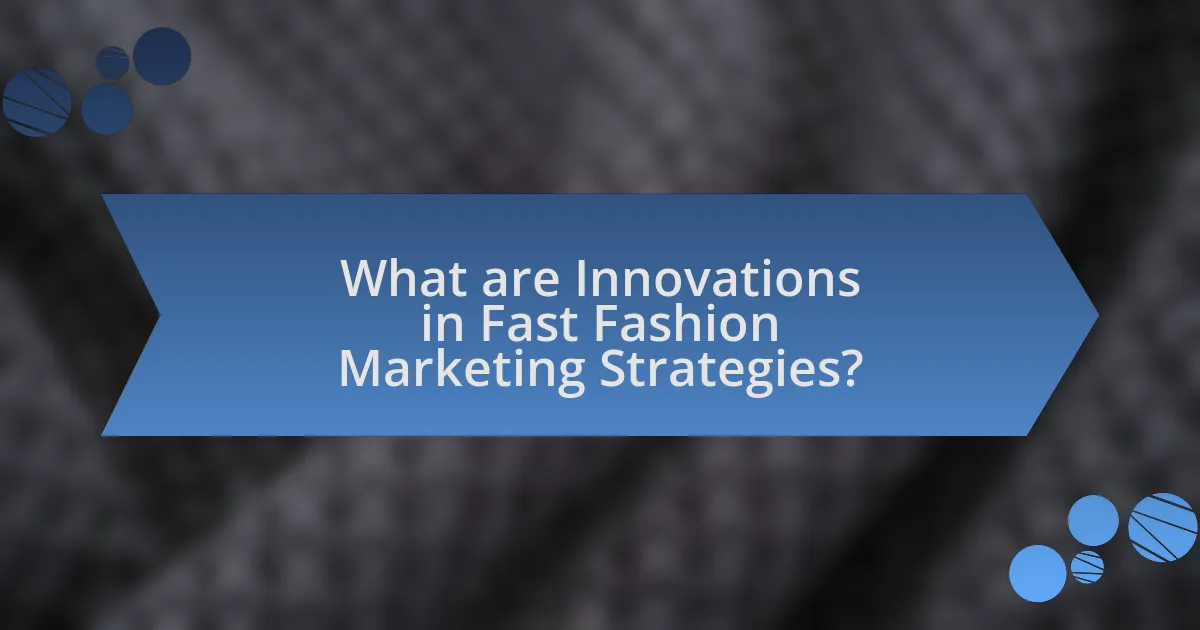Innovations in fast fashion marketing strategies encompass the integration of data analytics, social media engagement, and sustainability practices. Brands leverage data analytics to personalize marketing campaigns and optimize inventory, while social media platforms like Instagram and TikTok facilitate viral marketing through influencer partnerships. Additionally, the growing emphasis on sustainability reflects consumer demand for ethical practices, prompting brands to adopt eco-friendly materials and transparent supply chains. This article explores the evolution of marketing strategies in the fast fashion industry, the impact of technological advancements, and the role of consumer behavior in shaping these innovations.

What are Innovations in Fast Fashion Marketing Strategies?
Innovations in fast fashion marketing strategies include the use of data analytics, social media engagement, and sustainable practices. Data analytics enables brands to track consumer behavior and preferences in real-time, allowing for personalized marketing campaigns that resonate with target audiences. For instance, brands like Zara utilize customer data to optimize inventory and design decisions, leading to quicker turnaround times and increased sales. Social media engagement, particularly through platforms like Instagram and TikTok, allows brands to create viral marketing campaigns that reach a broader audience, exemplified by brands such as Fashion Nova, which leverages influencer partnerships to drive traffic and sales. Additionally, the integration of sustainable practices, such as eco-friendly materials and transparent supply chains, has become a key marketing strategy, appealing to environmentally conscious consumers and enhancing brand loyalty. Brands like H&M have launched sustainable collections and marketing campaigns to highlight their commitment to environmental responsibility, which has proven effective in attracting a growing segment of eco-aware shoppers.
How have marketing strategies evolved in the fast fashion industry?
Marketing strategies in the fast fashion industry have evolved from traditional advertising to a focus on digital engagement and sustainability. Initially, brands relied heavily on print media and television commercials to promote their products. However, with the rise of social media platforms like Instagram and TikTok, fast fashion companies now prioritize influencer partnerships and user-generated content to reach younger audiences effectively.
Additionally, the integration of data analytics has allowed brands to tailor their marketing efforts based on consumer behavior and preferences, leading to more personalized shopping experiences. For instance, companies like Zara and H&M utilize real-time sales data to adjust their inventory and marketing campaigns swiftly, ensuring they meet current trends.
Moreover, there is a growing emphasis on sustainability in marketing strategies, as consumers increasingly demand ethical practices. Brands are now highlighting eco-friendly initiatives and transparent supply chains in their campaigns to attract environmentally conscious shoppers. This shift is evidenced by the rise of campaigns promoting sustainable collections, such as H&M’s Conscious Collection, which aims to reduce environmental impact while appealing to a broader audience.
What technological advancements have influenced these marketing strategies?
Technological advancements such as artificial intelligence, big data analytics, and social media platforms have significantly influenced fast fashion marketing strategies. Artificial intelligence enables personalized shopping experiences through recommendation algorithms, enhancing customer engagement and conversion rates. Big data analytics allows brands to analyze consumer behavior and trends in real-time, facilitating agile inventory management and targeted marketing campaigns. Social media platforms serve as vital channels for brand promotion and customer interaction, with statistics showing that 54% of consumers use social media to research products before purchasing. These advancements collectively drive efficiency and responsiveness in fast fashion marketing.
How do consumer behaviors impact fast fashion marketing innovations?
Consumer behaviors significantly influence fast fashion marketing innovations by driving brands to adapt quickly to changing preferences and trends. As consumers increasingly prioritize sustainability, personalization, and digital engagement, fast fashion companies innovate their marketing strategies to meet these demands. For instance, a study by McKinsey & Company highlights that 67% of consumers consider the use of sustainable materials important, prompting brands to incorporate eco-friendly practices in their marketing narratives. Additionally, the rise of social media has led to innovations in influencer marketing, where brands leverage user-generated content to enhance authenticity and engagement. This shift reflects a direct response to consumer desires for relatable and transparent brand interactions.
What role does social media play in fast fashion marketing innovations?
Social media plays a crucial role in fast fashion marketing innovations by enabling brands to engage directly with consumers, facilitating rapid trend dissemination and feedback loops. Platforms like Instagram and TikTok allow brands to showcase new collections instantly, leveraging user-generated content and influencer partnerships to enhance visibility and drive sales. For instance, a study by the University of Southern California found that 70% of consumers are influenced by social media when making fashion purchases, highlighting its impact on consumer behavior. Additionally, social media analytics provide brands with real-time insights into consumer preferences, allowing for agile marketing strategies that respond to emerging trends quickly.
How do influencers shape consumer perceptions in fast fashion?
Influencers shape consumer perceptions in fast fashion by leveraging their social media platforms to create aspirational lifestyles that resonate with their followers. This impact is evident as influencers often showcase trendy outfits, promote brands, and engage in storytelling that aligns with the fast fashion ethos of immediacy and accessibility. Research indicates that 49% of consumers rely on influencer recommendations for their purchasing decisions, highlighting the significant role influencers play in shaping brand image and consumer trust. Furthermore, the visual nature of platforms like Instagram allows influencers to curate appealing content that enhances brand desirability, leading to increased consumer engagement and purchase intent.
What are the most effective social media platforms for fast fashion marketing?
The most effective social media platforms for fast fashion marketing are Instagram, TikTok, and Facebook. Instagram’s visual-centric approach allows brands to showcase their products through high-quality images and influencer partnerships, making it ideal for engaging fashion-conscious consumers. TikTok’s short-form video content enables brands to create viral trends and challenges, reaching younger audiences rapidly; in fact, 67% of TikTok users report being inspired to shop after seeing content on the platform. Facebook remains relevant due to its extensive user base and targeted advertising capabilities, allowing brands to reach specific demographics effectively. These platforms collectively enhance brand visibility and consumer engagement in the fast fashion sector.
Why is sustainability becoming a key focus in fast fashion marketing?
Sustainability is becoming a key focus in fast fashion marketing due to increasing consumer demand for environmentally responsible practices. Research indicates that 66% of global consumers are willing to pay more for sustainable brands, highlighting a significant shift in purchasing behavior. Additionally, regulatory pressures and the need for brands to enhance their corporate social responsibility are driving this focus. Fast fashion companies are responding by implementing sustainable materials, ethical labor practices, and transparent supply chains to align with consumer values and mitigate environmental impact.
How do brands communicate their sustainability efforts to consumers?
Brands communicate their sustainability efforts to consumers through transparent messaging, eco-labeling, and storytelling. For instance, many brands utilize social media platforms to share their sustainability initiatives, such as reducing carbon footprints or using recycled materials, which helps build consumer trust. Research indicates that 66% of global consumers are willing to pay more for sustainable brands, highlighting the importance of effective communication in influencing purchasing decisions. Additionally, brands often publish sustainability reports that detail their environmental impact and goals, further reinforcing their commitment to sustainability.
What challenges do fast fashion brands face in promoting sustainability?
Fast fashion brands face significant challenges in promoting sustainability, primarily due to their business model that prioritizes rapid production and low costs. This model often leads to environmental degradation, as the production processes are resource-intensive and generate substantial waste. For instance, the Ellen MacArthur Foundation reported that the fashion industry is responsible for 10% of global carbon emissions and is the second-largest consumer of water worldwide. Additionally, fast fashion brands struggle with consumer perception; many shoppers prioritize affordability and trendiness over sustainability, making it difficult for brands to shift towards eco-friendly practices without risking sales. Furthermore, the lack of transparency in supply chains complicates efforts to ensure sustainable sourcing and ethical labor practices, as highlighted by the Fashion Transparency Index, which shows that many brands do not disclose sufficient information about their supply chains.
How do data analytics enhance fast fashion marketing strategies?
Data analytics enhance fast fashion marketing strategies by enabling brands to understand consumer behavior and preferences in real-time. By analyzing data from various sources such as social media, sales transactions, and website interactions, fast fashion companies can identify trends, optimize inventory, and tailor marketing campaigns to specific target audiences. For instance, a study by McKinsey & Company found that data-driven companies in the fashion industry can increase their profitability by 5 to 10 percent through improved decision-making based on analytics. This capability allows brands to respond quickly to changing market demands, ensuring they remain competitive in a rapidly evolving industry.
What types of data are most valuable for fast fashion marketers?
Fast fashion marketers find customer behavior data, trend analysis data, and inventory management data to be the most valuable. Customer behavior data, including purchase history and browsing patterns, helps marketers understand consumer preferences and tailor marketing strategies accordingly. Trend analysis data, which encompasses social media trends and fashion forecasts, allows marketers to anticipate shifts in consumer demand and adapt their offerings. Inventory management data is crucial for optimizing stock levels and ensuring that popular items are readily available, thus minimizing lost sales opportunities. These data types collectively enhance decision-making and improve marketing effectiveness in the fast fashion industry.
How can data-driven insights improve customer engagement?
Data-driven insights can significantly improve customer engagement by enabling brands to tailor their marketing strategies based on consumer behavior and preferences. By analyzing data from various sources, such as purchase history, social media interactions, and website analytics, companies can identify trends and personalize their communication with customers. For instance, a study by McKinsey & Company found that companies leveraging customer data effectively can increase their marketing ROI by 15-20%. This targeted approach not only enhances customer satisfaction but also fosters brand loyalty, as customers feel more understood and valued.
What are the emerging trends in fast fashion marketing strategies?
Emerging trends in fast fashion marketing strategies include the increased use of social media influencers, sustainability initiatives, and data-driven personalization. Social media influencers play a crucial role in shaping consumer perceptions and driving sales, with brands leveraging platforms like Instagram and TikTok to reach younger audiences effectively. Sustainability initiatives are becoming essential as consumers demand more ethical practices; brands are adopting eco-friendly materials and transparent supply chains to appeal to environmentally conscious shoppers. Data-driven personalization enhances customer experiences by utilizing analytics to tailor marketing messages and product recommendations, leading to higher engagement and conversion rates. According to a 2022 McKinsey report, 67% of consumers are more likely to purchase from brands that demonstrate a commitment to sustainability, highlighting the importance of these trends in fast fashion marketing.
How is personalization changing the landscape of fast fashion marketing?
Personalization is transforming fast fashion marketing by enabling brands to tailor their offerings to individual consumer preferences, thereby enhancing customer engagement and loyalty. This shift is evident as companies leverage data analytics and artificial intelligence to analyze consumer behavior, allowing them to create personalized shopping experiences, such as customized recommendations and targeted advertising. For instance, a report by McKinsey & Company highlights that personalized marketing can lead to a 10-30% increase in sales, demonstrating the effectiveness of this strategy in driving revenue. Additionally, brands like Zara and ASOS utilize customer data to optimize inventory and design decisions, ensuring that they meet the specific demands of their target audience. This data-driven approach not only improves customer satisfaction but also streamlines operations, making personalization a crucial element in the evolving landscape of fast fashion marketing.
What impact do virtual and augmented reality have on consumer experiences?
Virtual and augmented reality significantly enhance consumer experiences by providing immersive and interactive environments that facilitate engagement and personalization. These technologies allow consumers to visualize products in a realistic context, leading to increased satisfaction and reduced return rates. For instance, a study by PwC found that 79% of consumers prefer to shop with brands that offer immersive experiences, indicating a strong preference for virtual and augmented reality applications in retail. Additionally, brands like IKEA and Sephora utilize augmented reality to enable customers to visualize furniture in their homes or try on makeup virtually, respectively, which has been shown to boost conversion rates and customer loyalty.
How can fast fashion brands effectively implement these innovations?
Fast fashion brands can effectively implement innovations by integrating advanced technologies such as artificial intelligence and data analytics into their supply chain and marketing strategies. For instance, utilizing AI can enhance inventory management and predict consumer trends, allowing brands to respond swiftly to market demands. A study by McKinsey & Company highlights that companies leveraging data analytics can improve their forecasting accuracy by up to 50%, leading to reduced waste and increased profitability. Additionally, adopting sustainable practices, such as using eco-friendly materials and transparent supply chains, can attract environmentally conscious consumers, as evidenced by a Nielsen report indicating that 73% of millennials are willing to pay more for sustainable brands. By combining technology with sustainability, fast fashion brands can not only innovate but also align with evolving consumer preferences.
What best practices should brands follow for successful marketing strategies?
Brands should focus on understanding their target audience to develop successful marketing strategies. This involves conducting thorough market research to identify customer preferences, behaviors, and trends. For instance, a study by McKinsey & Company highlights that brands that leverage data analytics to understand consumer behavior can increase their marketing effectiveness by up to 30%. Additionally, brands should prioritize creating engaging and authentic content that resonates with their audience, as 70% of consumers prefer brands that tell a story. Implementing a multi-channel approach, including social media, email marketing, and influencer partnerships, further enhances brand visibility and engagement. According to HubSpot, companies that utilize multiple channels in their marketing strategies see a 24% increase in customer engagement.
How can brands measure the success of their marketing innovations?
Brands can measure the success of their marketing innovations through key performance indicators (KPIs) such as sales growth, customer engagement, and brand awareness. By analyzing sales data before and after the implementation of a marketing innovation, brands can quantify the direct financial impact. For instance, a study by Nielsen found that 60% of consumers are more likely to purchase from brands that engage with them on social media, indicating that increased customer engagement can lead to higher sales. Additionally, brands can utilize surveys and analytics tools to assess changes in brand awareness and customer sentiment, providing a comprehensive view of the effectiveness of their marketing strategies.















